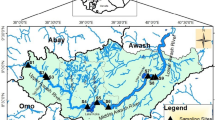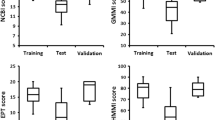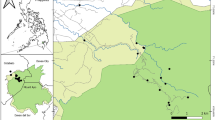Abstract
The ecological significance of freshwater ecosystems for conservation in the temperate zone has been determined by aquatic biologists using a variety of ecological techniques. One such tool is the Community Conservation Index (CCI), which was primarily developed in Britain but is also recommended for international use. The current study intends to further test the CCI’s applicability and its sensitivity in identifying freshwater systems of high conservation importance. The pristine condition of three natural monument (Arinta, Ekor, and Oowu waterfalls) streams was evaluated in this study using the macroinvertebrate metric indicators, and the results were compared with their CCIs. The relative compositions of stress-sensitive species, facultative species, functional feeding guilds (FFGs), and modes of locomotion or microhabitat preference (ML/MP) were selected as the macroinvertebrate metrics. The fauna was dominated by the taxonomic group EPT (Ephemeroptera, Plecoptera, Trichoptera), with the highest EPT-related metrics found at Oowu Waterfalls. Ironically, because a vulnerable species (i.e. Pentaphlebia stahli) is present there, the Ekor Waterfalls, which had the lowest values for the EPT-related metrics, had the highest CCI. Although both the CCI (>20) and macroinvertebrate metrics suggest that the three sites had high conservation value, the CCI proved to be more goal-oriented in determining the conservation value of pristine freshwater ecosystems. In light of the findings of this study, it is recommended that the CCI be utilized in conjunction with macroinvertebrate metric indicators for studies of a similar nature, particularly in Afrotropics’ protected and pristine sites that are a potential refuge for rare and threatened species.



Similar content being viewed by others
Data availability
The datasets generated and/or analyzed during the current study are available from the corresponding author on reasonable request.
References
Adkins JK, Rieske LK (2015) Benthic collectors and grazer communities are threatened by hemlock wooly adelgid-induced eastern hemlock loss. Forests 2015(6): 2719–2738. https://doi.org/10.3390/f6082719
Adamu JI (2020) Overview of the 2020 seasonal rainfall prediction. Nigeria Meteorological Agency, Abuja
Akindele EO, Liadi AA (2014) Diversity and response of benthic macroinvertebrates to natural and induced environmental stresses in Aiba stream, Iwo, southwestern Nigeria. West Afr J Appl Ecol 22(1):101–111. https://www.ajol.info/index.php/wajae/article/view/108003
Akindele EO, Olutona GO (2017) Water quality and biodiversity of potamoplankton in an African sacred grove and world heritage site. Zool Ecol 27(3–4):292–303. https://doi.org/10.1080/21658005.2017.1357290
Akindele EO, Adeniyi AV, Oyeku OG, Adu BW (2018) Analysis of benthic macroinvertebrates, biological water quality and conservation value of a tropical river and UNESCO-protected environment. Afr J Ecol 56:488–498. https://doi.org/10.1111/aje.12482
Akindele EO, Omisakin OD, Oni OA, Aliu O, Omoniyi GE, Akinpelu OT (2020) Heavy metal toxicity in the water column and benthic sediments of a degraded tropical stream. Ecotoxicol Environ Safe 190(2020):110153. https://doi.org/10.1016/j.ecoenv.2019.110153
Akindele EO, Adedapo AM, Adu BW, Ogbogu SS (2021) First report of the larva of a vulnerable damselfly in Nigeria: a case for umbrella species conservation approach. Trop Conserv Sci 14:1–7. https://doi.org/10.1177/19400829211044629
Akindele EO, Adedapo AM, Fagbohun IR, Akinpelu OT, Amoo TO, Aliu OO, Adeniyi AV (2022) Conservation evaluation of three Nigerian streams in different vegetation zones demonstrates why pristine freshwater ecosystems in the Afrotropics should be protected. Aquat Conserv: Mar Freshw Ecosyst 32:702–709. https://doi.org/10.1002/aqc.3778
Akinpelu AI, Areo A (2007) The snakes of Osun Grove: a world heritage site in Osogbo, Nigeria. Rev Biol Trop 55:717–721.
Aliu OO, Akindele EO, Adeniyi IF (2020) Biological assessment of the headwater rivers of Opa reservoir, Ile-Ife, Nigeria, using ecological methods. J Basic Appl Zool 81:11. https://doi.org/10.1186/s41936-020-00151-5
Ausden M (2000) Invertebrates. In: Sutherland WJ (ed) Ecological census techniques: a handbook, Cambridge University Press, Cambridge, pp 139–177
APHA, AWWA, WEF (1998) Standard methods for the examination of water and waste water (20th ed.). American Public Health Association, American Water Works Association and Water Environmental Federation, Washington DC
Arimoro FO, Ikomi RB (2008) Response of macroinvertebrate communities to abattoir wastes and other anthropogenic activities in a municipal stream in the Niger Delta, Nigeria. Environmentalist 28:85–98. https://doi.org/10.1007/s10669-007-9033-8
Arimoro FO, Keke UN (2016) The intensity of human-induced impacts on the distribution and diversity of macroinvertebrates and water quality of Gbako River, north central, Nigeria. Energy Ecol Environ 2:143–154. https://doi.org/10.1007/s40974-016-0025-8
Arimoro FO, Ogbeibu AE, Raifu FF (2007) Phytophilous macroinvertebrates of floating Nymphaea lotus and Pistia stratiotes in river Orogodo, Niger Delta. Nigeria Trop Freshw Biol 16(1):75–87.https://www.ajol.info/index.php/tfb/article/view/20905
Barbour MT, Gerritsen J, Griffith GE, Frydenborg R, McCarron E, White JS, Bastian ML (1996) A framework for biological criteria for Florida streams using benthic macroinvertebrates. J North Am Benthol Soc 15:185–211. https://doi.org/10.2307/1467948
Barman B, Gupta S (2015) Spatial distribution and functional feeding groups of aquatic insects in a stream of Chakrashila wildlife sanctuary, Assam, India. Knowl Manag Aquat Ecosyst 416:37. https://doi.org/10.1051/kmae/2015028
Camara I, Kra M, Kouadio N, Konan M, Edia E, Doumbia L, Ouattara A, Diomande D (2020) Composition, structure and functional feeding of aquatic entomofauna in Kodjoboué Lake: water quality assessment. Open J Ecol 10:160–176. https://doi.org/10.4236/oje.2020.104011
Céréghino R, Park Y, Compin A, Lek S (2003) Predicting the species richness of aquatic insects in streams using a limited number of environmental variables. J North Am Benthol Soc 22:442–456. https://doi.org/10.2307/1468273
Chadd R (2010) Assessment of aquatic invertebrates. In: Hurford C, Schneider M, Cowx I (eds) Conservation monitoring in freshwater habitats: a practical guide and case studies. Springer, Dordrecht, pp 63–72
Chadd R, Extence C (2004) The conservation of freshwater macroinvertebrate populations: a community-based classification scheme. Aquat Conserv Mar Freshw Ecosyst 14:597–624. https://doi.org/10.1002/aqc.630
Chapman D, Kimstach V (2006) Selection of water quality variables. In: Chapman D (ed) Water quality assessments. Chapman and Hall, London, pp 65–122
Clark TE, Samways MJ (1996) Dragonflies (Odonata) as indicators of biotype quality in he Kruger National Park, South Africa. J Appl Ecol 33:1001–1012. https://doi.org/10.2307/2404681
Compin A, Céréghino R (2003) Sensitivity of aquatic insect species richness to disturbance in the Adour–Garonne stream system (France). Ecol Indic 3:135–142. https://doi.org/10.1016/S1470-160X(03)00016-5
Cummins KW, Wilzbach MA, Gates DM, Perry JB, Taliaferro WB (1989) Shredders and riparian vegetation. Bioscience 39:24–30. https://doi.org/10.2307/1310804
Darwall W, Smith K, Lowe T, Vié. JC (2005) The status and distribution of freshwater biodiversity in Eastern Africa. IUCN SSC Freshwater Biodiversity Assessment Programme. IUCN, Gland
de Moor IJ, Day JA, de Moor FC (2003) Guides to the freshwater invertebrates of southern Africa, Volume 7: Insecta I Ephemeroptera, Odonata and Plecoptera. WRC Report No. TT 207/03, Water Research Commission, Gezina
Dijkstra K-DB, Tchibozo S, Ogbogu SS (2009) The status and distribution of dragonflies and damselflies (Odonata) in western Africa (2009). In: Smith KG, Diop MD, Niane M, Darwall WRT (eds) The status and distribution of freshwater biodiversity in Western Africa. IUCN, UK, Gland, pp 41–55
Dudley N, Stolton S (2008) Introduction. In: Dudley N, Stolton S (eds) Defining protected areas: an international conference in Almeria, Spain. IUCN, Gland, pp 9–11
Edegbene AO, Arimoro FO (2012) Ecological status of Owan River, southern Nigeria using aquatic insects as bioindicators. J Aquat Sci 27(2):99–111. https://www.ajol.info/index.php/jas/cart/view/102206/92245
Furse MT (2000) The application of RIVPACS procedures in headwater streams-an extensiveand important national resource. In: Wright JF, Sutcliffe DW, Furse MT (eds) Assessing the biological quality of freshwaters: RIVPACS and other techniques. Freshwater Biological Association, AMBLESIDE, pp 79–91
Gabriels W, Lock K, De Pauw N, Goethals PLM (2010) Multimetric macroinvertebrate index Flanders (MMIF) for biological assessment of rivers and lakes in Flanders (Belgium). Limnologica 40:199–207. https://doi.org/10.1016/j.limno.2009.10.001
Goki NG, Iyakwari SA, Umbugadi AA (2018) Geotourism and mining heritage: a potential gold mine for Central Nigeria. Acta Geoturistica 9(1):9–22. https://doi.org/10.1515/agta-2018-0002
Gonçalves JR, França JS, Medeiros AO, Rosa CA, Callisto M (2006) Leaf breakdown in a tropical stream. Int Rev Hydrobiol 91:164–177. https://doi.org/10.1002/iroh.200510826
Hambler C, Canney SM (2013) Conservation, 2nd edn. Cambridge University Press, New York
Hoffmann S, Steiner L, Schweiger AH, Chiarucci A, Beierkuhnlein C (2019) Optimizing sampling effort and information content of biodiversity surveys: a case study of alpine grassland. Ecol Inform 51:112–120. https://doi.org/10.1016/j.ecoinf.2019.03.003
Ikomi RB, Arimoro FO (2014) Effects of recreational activities on the littoral macroinvertebrates of Ethiope River, Niger Delta, Nigeria. J Aquat Sci 29(1B):155–170. https://www.ajol.info/index.php/jas/article/view/102322
IUCN (2015) The IUCN Red List of Threatened Species™. Gland
IUCN (2021) Category III: Natural Monument or Feature. Available at: https://www.iucn.org/theme/protected-areas/about/protected-areas-categories/categoryiii-natural-monument-or-feature. Accessed 27 Nov 2021
Jones JC, Reynolds JD (2000) Environmental variables. In: Sutherland WJ (ed) Ecological census techniques: a handbook. Cambridge University Press, Cambridge, pp 281–316
Kaboré I, Moog O, Alp M, Guenda W, Koblinger T, Mano K, Ouéda A, Ouédraogo R, Trauner D, Melcher AH (2016) Using macroinvertebrates for ecosystem health assessment in semi-arid streams of Burkina Faso. Hydrobiologia 766:57–74. https://doi.org/10.1007/s10750-015-2443-6
Kobingi N, Raburu PO, Masese FO, Gichuki J (2009) Assessment of pollution impacts on the ecological integrity of the Kisian and Kisat rivers in Lake Victoria drainage basin, Kenya. Afr J Environ Sci Technol 3:97–107. https://doi.org/10.5897/AJEST.9000011
Kristensen TK, Stensgaard AS, Seddon MB, McIvor A (2009) The status and distribution of freshwater molluscs (Mollusca). In: Smith KG, Diop MD, Niane M, Darwall WRT (eds) The status and distribution of freshwater biodiversity in Western Africa, Cambridge, pp 33–40
Li AO, Dudgeon D (2009) Shredders: species richness, abundance, and role in litter breakdown in tropical Hong Kong streams. J North Am Benthol Soc 28:167–180. https://doi.org/10.1899/08-043.1
Lopes-Lima M, Burlakova LE, Karatayev AY, Mehler K, Seddon M, Sousa R (2018) Conservation of freshwater bivalves at the global scale: diversity, threats and research needs. Hydrobiologia 810(1):1–14. https://doi.org/10.1007/s10750-017-3486-7
López-López E, Sedeño-Díaz JE (2015) Biological indicators of water quality: the role of fish and macroinvertebrates as indicators of water quality. In: Armon R, Hännien O (eds) Environmental Indicators. Springer, Dordrecht. https://doi.org/10.1007/978-94-017-9499-2_37
Mangadze T, Bere T, Nwedzi T (2016) Choice of biota in stream assessment and monitoring programs in tropical streams: a comparison of diatoms, macroinvertebrates and fish. Ecol Indic 63:128–143. https://doi.org/10.1016/j.ecolind.2015.11.029
Masese FO, Raburu PO (2017) Improving the performance of the EPT index to accommodate multiple stressors in Afrotropical streams. Afr J Aquat Sci 42(3):219–233. https://doi.org/10.2989/16085914.2017.1392282
Masese FO, Raburu PO, Muchiri M (2009) A preliminary benthic macroinvertebrate index of biotic integrity (B-IBI) for monitoring the Moiben River, Lake Victoria Basin, Kenya. Afr J Aquat Sci 34:1–14. https://doi.org/10.2989/AJAS.2009.34.1.1.726
Mazzacano CA (2014) Aquatic macroinvertebrates: ecosystem services and implications for river restoration. The Xerces Society for Invertebrate Conservation, 13th Annual Northwest Stream Restoration Symposium Stevenson, WA
Mbogho AY, Sites RW (2013) Naucoridae leach, 1815 (Hemiptera: Heteroptera) of Tanzania. Afr Invertebr 54(2):513–542. https://doi.org/10.5733/afin.054.0218
Mereta ST, Boets P, De Meester L, Goethals PLM (2013) Development of a multimetric index based on benthic macroinvertebrates for the assessment of natural wetlands in Southwest Ethiopia. Ecol Indic 11:510–521. https://doi.org/10.1016/j.ecolind.2013.01.026
Merritt RW, Cummins KW (1996) An introduction to the aquatic insects of North America, 3rd edn. Kendall/Hunt Publishing Company, Dubuque
Minaya V, McClain ME, Moog O, Omengo F, Singer GA (2013) Scale-dependent effects of rural activities on benthic macroinvertebrates and physico-chemical characteristics in headwater streams of the Mara River, Kenya. Ecol Indic 32:116–122. https://doi.org/10.1016/j.ecolind.2013.03.011
Moldenke AR, ver Linden C (2007) Effects of clearcutting and riparian buffers on the yield of adult aquatic macroinvertebrates from headwater streams. For Sci 53(2): 308–319. https://doi.org/10.1093/forestscience/53.2.308
Naiman RJ, Decamps H, McClain MER (2005) Riparia: ecology, conservation and management of streamside communities. Elsevier, San Diego
Nel JL, Roux DJ, Maree G, Kleynhans CJ, Moolman J, Reyers B, Rouget M, Cowling RM (2007) Rivers in peril inside and outside protected areas: a systematic approach to conservation assessment of river ecosystems. Divers Distrib 13:341–352. https://doi.org/10.1111/j.1472-4642.2007.00308.x
Onyekwelu JC, Olusola JA (2014) Role of sacred grove in in-situ biodiversity conservation in rainforest zone of Southwestern Nigeria. JTFS 26(1):5–15. https://jtfs.frim.gov.my/jtfs/article/view/237
Pawley S, Dobson M, Fletcher (2011) Guide to British freshwater macroinvertebrates for biotic assessment. Freshwater Biological Association
Reif AG (2002) Assessment of stream quality using biological indices at selected sites in the Red Clay and White Clay Creek Basins, Chester County, Pennsylvania, 1981–97. Chester County Water Resources Authority Government Center, 601 Westtown Road West Chester, PA. https://doi.org/10.3133/fs11702
Resende PC, Resende P, Pardal M, Almenda S, Azeiteiro U (2010) Use of biological indicators to assess water quality of the UI River (Portugal). Environ Monit Assess 170:535–544. https://doi.org/10.1007/s10661-009-1255-4
Rowell TJ, Sobczak WV (2008) Will stream periphyton respond to increases in light following forecasted regional hemlock mortality? J Freshw Ecol 23:33–40. https://doi.org/10.1080/02705060.2008.9664555
Sonneman JA, Walsh CJ, Breen PF, Sharpe AK (2001) Effects of urbanization on streams of the Melbourne region, Victoria, Australia II. Benthic diatom communities. Freshw Biol 46:553–565. https://doi.org/10.1046/j.1365-2427.2001.00690.x
Sreerenjini K, Sunil SR (2016) Assessment of biological water quality based on functional feeding groups of benthic macroinvertebrates: a case study of Pampa River. Indian J Ecol 48(3):837–841. https://pubag.nal.usda.gov/catalog/7477155
Stals R, de Moor IJ (2008) Guides to the freshwater invertebrates of southern Africa. 10: Coleoptera. Afr J Aquat Sci 34(2). https://doi.org/10.4001/003.017.0218
Stewart DAB, Samways MJ (1998) Conserving dragonfly (Odonata) assemblages relative to river dynamics in an African savannah game reserve. Conserv Biol 12:683–692. https://doi.org/10.1111/j.1523-1739.1998.96465.x
Suhling F, Muller O, Martens A (2014) The dragonfly larvae of Namibia (Odonata). Libellula Zeitschrift der Gesellschaft deutschsprachiger Odonatologen (GdO) e.V., Bremen, Supplement 13:5–106
Umar DM, Harding JS, Winterbourn MJ (2013) Freshwater invertebrates of the Mambilla plateau, Nigeria. School of Biological Sciences, University of Canterbury, Christchurch
Vannote RL, Minshall GW, Cummins KW, Sedell JR, Cushing CE (1980) The river continuum concept. Can J Fish Aquat 37:130–137. https://doi.org/10.1139/f80-017
Voshell JR (2002) A guide to freshwater invertebrates of North America. The McDonald and Woodland Publishing Company, Granville
Wheatly MG (1999) Calcium homeostasis in Crustacea: the evolving role of branchial, renal, digestive and hypodermal epithelia. J Expl Zool 283:620–640. https://doi.org/10.1002/(SICI)1097-010X(19990601)283:7%3C620::AID-JEZ2%3E3.0.CO;2-3
Wright JF (1997) An introduction to RIVPACS. In: Wright JF, Sutcliffe DW, Furse MT (eds) Assessing the biological quality of freshwaters: RIVPACS and other techniques. Freshwater Biological Association, pp 1–24
Acknowledgments
Special thanks to the Ekiti State Ministry of Tourism, Abia Local Community, and the Owa Onire Community for granting the research team access to the sites. Authors would also like to thank the field assistants (Messrs Femi Idowu, Akpan, Emmanuel Cletus, Gabriel and Akanbi) for their logistical assistance during the field work.
Funding
This study was supported by a research grant (EA20/1246, 2020) awarded to Emmanuel O. Akindele by the British Ecological Society.
Author information
Authors and Affiliations
Corresponding author
Ethics declarations
Ethics approval
Not applicable.
Conflict of interest
The authors declare that they have no competing interest.
Additional information
Publisher’s note
Springer Nature remains neutral with regard to jurisdictional claims in published maps and institutional affiliations.
Supplementary Information
ESM 1
(DOCX 51 kb)
Rights and permissions
Springer Nature or its licensor (e.g. a society or other partner) holds exclusive rights to this article under a publishing agreement with the author(s) or other rightsholder(s); author self-archiving of the accepted manuscript version of this article is solely governed by the terms of such publishing agreement and applicable law.
About this article
Cite this article
Akindele, E.O., Adedapo, A.M., Fagbohun, I.R. et al. Macroinvertebrate metric indicators should be juxtaposed with the community conservation index as ecological tools for conservation evaluation of pristine freshwater ecosystems. Biologia 78, 1067–1078 (2023). https://doi.org/10.1007/s11756-023-01315-8
Received:
Accepted:
Published:
Issue Date:
DOI: https://doi.org/10.1007/s11756-023-01315-8




